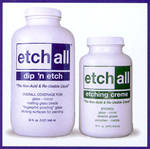|
Chemical
Etching
| Instead
of sandblasting the glass, there is a chemical process that
will produce similar results to sandblast surface etching. Advantages
of this process are that it is easy and simple and doesn’t require
the equipment for abrasive etching. A beginner can produce etched
glassware and small flat pieces of glass and mirror with no
experience. Disadvantages of the process are that the etch produced
by the chemical is not as strong or as bright and white as the
blasted finish. It is also not as consistent as the blasted
finish, with possible streaking and splotching of the finish. |

Example
of one type of etching creme and dipping solution. |
Of course, the
etching chemical (generally called etching creme at hobby shops)
cannot cut into the glass, so you can’t carve the glass like you
can with blasting. This means either single stage or multi-stage
carving. You can’t do the shading technique with etching creme,
either. So using chemical etching is much more limited than blasting,
but it can get you started doing small surface etchings right now,
at a very low expense. Sometimes, beginners and hobbyests start
with etching creme, then move on to blasting.
In addition
to the thick creme compound, there is now available a very thin
etching liquid intended for fosting round objects. Things like perfume
bottles and other bottles can be put into this liquid for frosting.
This liquid can also be used over a blasted finish to make the blasted
finish “fingerprint proof”, since handling blast etched glass can
discolor it with fingerprints in some situations.
To use the etching
creme, simply prepare a design the same way you would for abrasive
blasting, then apply the creme according to the manufacturer’s instructions,
clean it off after the prescribed amount of time and you are finished.
Total amount of time required for the etching itself is from 2 to
10 minutes. To review the instructions for preparing a design for
blast etching, see the page “How do you etch glass?”.
There are a
few different chemical compounds available, under different brand
names. If you want to do chemical etching, be sure to check out
the more expensive compounds. The extra cost is more than made up
for by the fact that they are re-usable, drastically reducing the
cost per use of the compound. Something else to look for is a compound
that is environmentally friendly, which may cost more, but is well
worth it if you are concerned about the environment. Check for these
etching compounds at your local stained glass shop or hobby shop.
*Note:
Do not confuse using etching creme with traditional acid etching,
which is done with hydrofluoric acid. This is an extremely dangerous
acid and should NEVER be used by anyone who has not had extensive
training. We have been personally acquainted with 3 people who have
come in contact with only a drop or two of this acid and who have
almost lost fingers or hands as a result. In addition, it is classified
as a hazardous material and must be disposed of in a waste site
for hazardous materials, a very expensive proposition.
|





